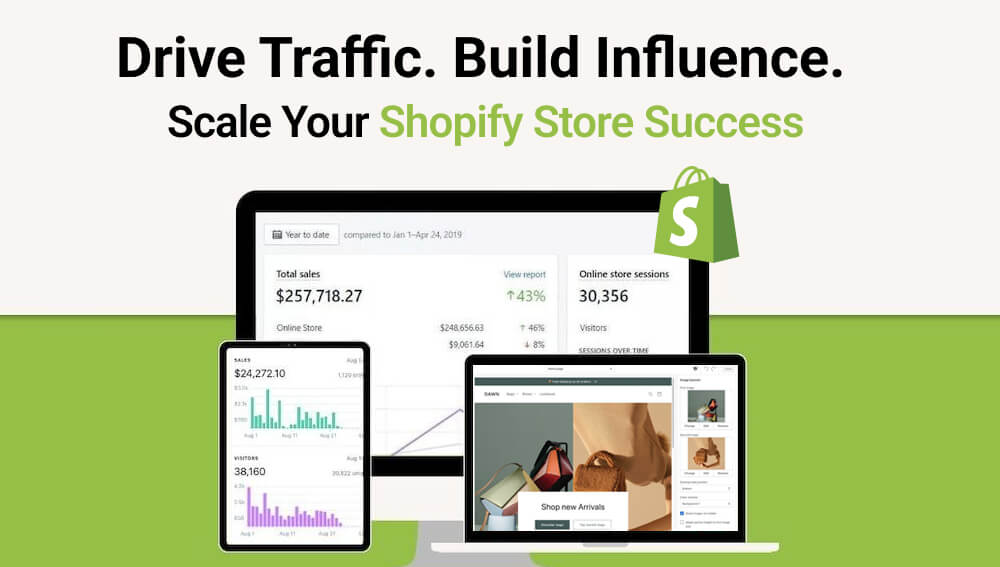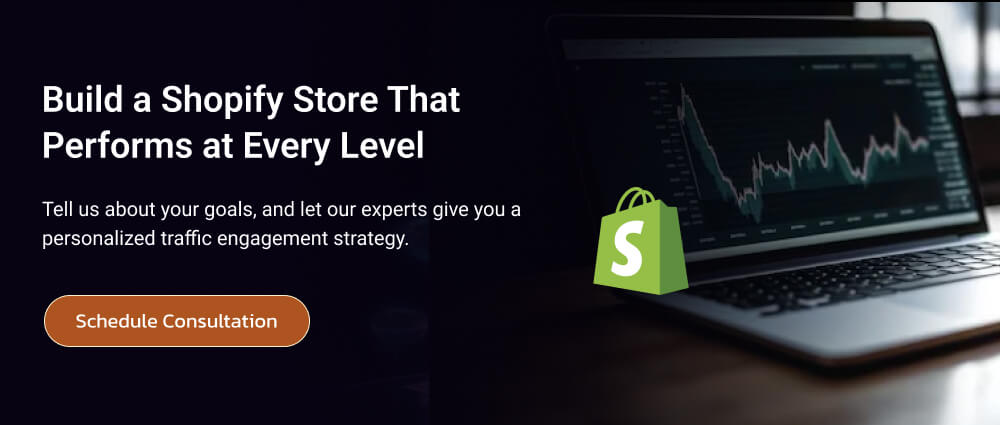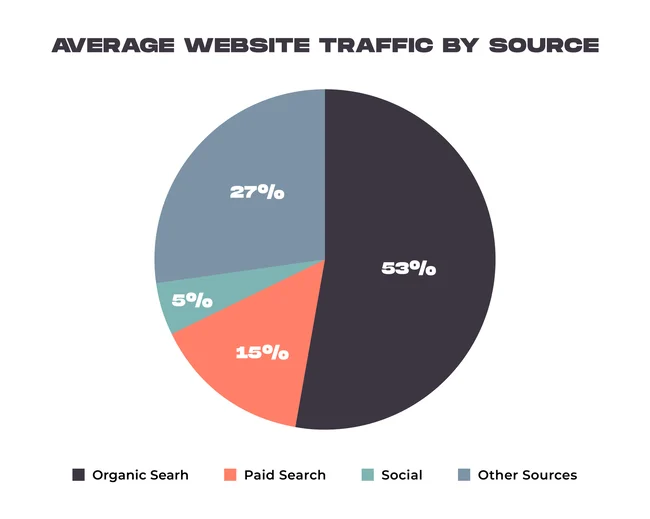
In a marketplace defined by infinite choice and limited attention, visibility is no longer accidental but engineered. Today, 44% of online shoppers start their product search with search engines, not marketplaces or brand websites. [Source: Klarna Insights] This means the battle for growth begins long before a customer reaches your product page.
Shopify has emerged as a dominant platform for commerce because of its flexibility, scalability, and ecosystem of marketing and optimization apps. But tooling alone doesn’t generate demand. The brands capturing disproportionate growth in 2025 are those rethinking how they drive discovery, engagement, and retention using AI-driven insight loops.
According to the Uptek report, the average conversion rate for Shopify stores is approximately 1.4%. This means that, on average, 1.4% of visitors to a Shopify store purchase. If your store’s conversion rate is below 0.5%, there’s likely potential for improvement.
Traffic is not just a top-of-funnel metric anymore. It is a performance ecosystem integrating acquisition, relevance, personalization, and experience optimization. And AI is now at the center of that system. Brands that integrate AI into their traffic, engagement, and conversion pipelines will scale. Those that don’t will be pushed out by algorithmic competition.
This blog explores how to drive traffic to your Shopify store using AI-powered solutions. How merchants can operationalize it, and the strategies reshaping acquisition and conversion efficiency today.
- The New Reality of Shopify Competition
- Why Your Shopify Store Might Be Losing Traffic
- Major Sources of Shopify Website Traffic
- Tips to Make a Shopify Website Traffic-Friendly
- Core Traffic-Driving Strategies for Shopify Stores
- Future Trends Shaping Shopify Traffic Growth
- Concluding Thoughts
- Frequently Asked Questions
- Why should traffic growth be treated as a performance ecosystem rather than a marketing activity?
- How can Shopify merchants balance automation and personalization without losing authenticity?
- What differentiates high-value traffic from high-volume traffic?
- How do AI and predictive analytics reshape Shopify traffic strategies?
The New Reality of Shopify Competition
Over 30% merchants in the USA run their business on Shopify today. From startups to global brands, the platform has streamlined the online selling process. But this has intensified the competition to drive potential web traffic. Standing out isn’t simply having a store; it’s about strategic discoverability.
Shopify offers a strong foundation with its SEO-ready structure, built-in apps, and flexible marketing tools. But visibility doesn’t happen automatically; it requires proper strategies and teamwork. The most successful brands treat traffic not as a number, but as a performance catalyst that drives continuous growth.
To truly increase traffic on a Shopify store, businesses must bring technical optimization, audience intelligence, and omnichannel marketing within the unified growth engine.
Why Your Shopify Store Might Be Losing Traffic
Even well-optimized Shopify stores can experience a sudden dip in traffic due to unexpected reasons. Traffic loss is a clear indication of ecosystem inefficiencies, not just poor marketing. Proper knowledge of these signs helps prevent revenue leakage and ensure long-term visibility.
1. SEO Decay and Content Stagnation
Search engines reward freshness and relevance. Over time, blogs, product pages, or collections start to lose ranking authority if not updated. Neglecting Shopify SEO tips like refreshing metadata, internal links, and schema markup can push your site down the SERP.
2. Poor Site Performance
Even a one-second delay can result in conversions and rankings loss. As new apps, plugins, and scripts accumulate, your Shopify store’s speed deteriorates. This not only frustrates users but also signals to Google that your site isn’t optimized for experience.
3. Outdated User Experience (UX)
Design trends and customer behaviors change rapidly. A UX that was appealing two months ago may now feel dated. If navigation, checkout flows, or product discovery are not properly aligned with the buyer’s expectations, users bounce instantly.
4. Weak Data Insights and Tracking
Many stores collect data analytics but fail to drive insights effectively. If decisions aren’t data-informed, marketing spend often misfires, and valuable audiences go unrecognized.
5. Algorithm Shifts and Market Competition
Search and social algorithms evolve frequently. Competitors investing in content and backlinks can easily outrank outdated stores. Traffic dips show stronger market players are adapting faster to new technological change.
Major Sources of Shopify Website Traffic
Not all traffic is generated equally. For a Shopify store, visitors arrive through multiple sources, including organic search, paid campaigns, referrals, social media platforms, email marketing, or direct visits. Each channel has a different role in contributing to visibility, intent, and conversion.
- Organic Traffic: Driven by SEO and content marketing, this delivers the highest ROI over time but demands patience and consistency.
- Paid Traffic: Quick and measurable but cost-sensitive; ideal for promotions and early traction.
- Social Media Referrals: Excellent for engagement and awareness, especially when tied to influencer partnerships.
- Email Traffic: Retention-centric; nurtures loyalty and repeat sales.
- Direct & Referral Traffic: Reflects brand strength, often from earned trust or affiliate relationships.
Understanding the ratio of these traffic sources helps build successful Shopify marketing strategies that ensure both short-term spikes and long-term stability.
Tips to Make a Shopify Website Traffic-Friendly
Before asking how to attract targeted traffic to a Shopify store, it’s essential to ensure the store can handle and convert it efficiently. Driving users to a poorly optimized website is a costly mistake.
a. Optimize the User Experience (UX)
- Focus on mobile responsiveness, as over 70% of Shopify traffic comes from different mobile devices.
- Make navigation simple with clear menus, breadcrumb trails, and logical categories.
- Use clean product pages including descriptive titles, sharp visuals, and scannable bullet points.
b. Strengthen Technical Infrastructure
- Prioritize Shopify optimization services, such as CDN integration, image compression, and caching, to improve load times.
- Validate technical SEO with sitemap.xml, robots.txt, canonical tags, and schema markup.
- Integrate Google Analytics 4 and Meta Pixel to measure cross-channel performance.
c. Brand Consistency and Trust
- Ensure authenticity with consistency in tone, visuals, and communication.
- Integrate social proof like user reviews, trust badges, and transparent policies to reduce friction.
Building a strong foundation ensures every click counts. Without it, even the best marketing efforts underperform. To get additional help, consult Shopify development services; they will ensure your website has all the crucial sections for visitor engagement and ROI.

Core Traffic-Driving Strategies for Shopify Stores
You have done solid groundwork for your store. Let’s move to the actual discussion of the blog: proven strategies to increase Shopify traffic. These aren’t shortcuts; they are growth mechanisms focused on visibility, engagement, and conversion.
A. SEO and Content to Build a Strong Organic Presence
1. On-Page Optimization
Implement Shopify SEO tips to boost organic traffic:
- Optimize product titles, meta descriptions, and image alt texts.
- Use clean URLs and structured data to enhance discoverability.
- Create topic clusters around your primary keywords, not just product pages, but also supporting blog posts to resolve user queries.
AI helps brands:
- Analyze search patterns in real time
- Identify topic clusters instead of keywords
- Optimize product descriptions based on conversion likelihood
- Dynamically rewrite metadata as seasonal behavior changes
Read More: SEO Tips to Boost Shopify Store Conversion
2. Content Marketing for Shopify
- Develop educational blog content focusing on “how-to” guides, buying tips, and comparison posts aligned with customer intent.
- Use Shopify’s built-in blog or integrate a content CMS for scalability.
- Incorporate storytelling to connect emotion with value, a major eCommerce content strategy.
AI tools can:
- Predict content demand cycles
- Generate outline frameworks that match buyer intent
- Repurpose one content asset into 10 formats (Reels, email, articles, product stories)
3. Backlink and Partner Ecosystem
Collaborate with bloggers, niche websites, and affiliates to strengthen authority and referral visibility. When combined with structured content optimization, organic visibility grows exponentially without relying solely on ads.
B. Paid Marketing for Targeted Visibility
1. Paid Ads (Google Ads)
People from across the globe use Google to search 8.5 billion times per day. Invest in keyword-driven Google Ad campaigns to attract users actively seeking products. Build a strategy around combining dynamic search ads with shopping campaigns to optimize reach.
2. Paid Social Campaigns
Consult experts for paid marketing strategies for Shopify stores using platforms like Meta, TikTok, Instagram, and Pinterest. These channels drive top-of-funnel engagement and help retarget users later.
3. Performance Optimization
Continuously check CPC, CTR, and conversion metrics to ensure paid ads align with your Shopify conversion optimization goals.
Paid strategies deliver precision, but they work best when combined with organic and retention channels for long-term sustainability.
C. Boost Social Media & Influencer Ecosystems
Social media is one of the best ways to promote your Shopify store online. It’s not just about presence but participation.
- Promote product experiences on Instagram Reels and YouTube Shorts for engagement.
- Collaborate with influencers; their audiences often convert better due to higher trust.
- Launch interactive polls, UGC contests, and product comparisons to humanize your brand.
AI tools analyze:
- Engagement sentiment
- Community interactions
- Influencer resonance
- Visual trend patterns
Once you hire Shopify developer, they will strategically apply social media to grow Shopify sales by blending entertainment with engagement.
D. Email Marketing as Hidden Traffic Multiplier
Traffic is not always about the “new.” Often, it means returning, where email marketing strategies for Shopify come in.
- Use personalized campaigns powered by Shopify Email or integrations like Klaviyo.
- Segment audiences based on cart abandoners, frequent buyers, and dormant users.
- Automate lifecycle flows, including welcome sequences, re-engagement campaigns, and loyalty updates.
Email marketing not only drives traffic but also improves Shopify conversion optimization by nurturing repeat sales.
E. Partnerships, Referrals, and Community-Building
Referrals remain one of the most authentic and effective marketing channels for Shopify stores.
- Launch affiliate programs or partnerships with creators.
- Encourage user-generated content and referral incentives.
- Build communities (Discord, Facebook Groups) where customers share their views and interact beyond transactions.
Traffic from these networks is highly targeted and trust-driven, making it more conversion-efficient than just acquisition.
F. Automation and Smart Marketing Tools
Leverage Shopify marketing tools to automate complex workflows:
- Abandoned cart recovery systems.
- Dynamic product recommendations via AI-driven apps.
- CRM integrations to align sales and marketing data.
With these, your Shopify store will be a self-optimizing marketing engine, ensuring outreach without diluting personalization.
Future Trends Shaping Shopify Traffic Growth
The methods that work today will evolve rapidly with new algorithms and technological changes. Staying ahead means predicting how customers will discover, engage, and purchase from an eCommerce store.
1. AI-Driven Personalization and Predictive Targeting
Artificial intelligence is redefining Shopify marketing strategies by making every interaction context-aware. The AI development services now analyze browsing behavior, purchase history, and engagement data to predict what users are likely to buy next. This creates smarter product recommendations, dynamic landing pages, and automated ad targeting.
2. Voice and Visual Search Optimization
As more users rely on smart devices, Shopify merchants boost organic traffic by including voice and image queries. Stores that structure product data with conversational keywords and rich media metadata will dominate the next generation of search-driven discovery.
3. Social Commerce Ecosystems
Platforms like TikTok, Instagram, Meta, and YouTube are becoming direct commerce hubs. Integrating Shopify marketing tools with these platforms allows brands to capture buyers where attention is already concentrated. This major evolution redefines how to use social media to grow Shopify sales beyond branding to direct conversions.
4. APIs for Omnichannel Synchronization
Future-ready stores will operate as unified ecosystems, not isolated channels. APIs will connect inventory, CRM, marketing, and analytics across systems for real-time personalization and cohesive customer experiences. Incorporating Shopify integration services ensures that every channel feeds into one consistent brand narrative.
5. Sustainable and Ethical Commerce Signals
Consumers are increasingly conscious of sustainability and transparency. Highlighting eco-friendly workflow, ethical production, and carbon-neutral shipping directly influences CTR and brand loyalty. Partnering with expert eCommerce development services can help Shopify merchants integrate sustainability-focused features into their stores.

Concluding Thoughts
Getting traffic to your Shopify store is not a one-time campaign, but it is a continuous process of visibility, interaction, and improvement. Success comes from designing a complete funnel experience that includes the initial click to the last purchase, and even beyond. Consistency, data intelligence, and customer empathy are what make winning Shopify brands beat short attention spans and ruthless competition.
Whether you are maximizing organic discovery, extending paid visibility, or re-engaging through automation, keep in mind: each click must have a reason to establish a long-term relationship with your audience. When you are willing to transform your Shopify presence into a true growth engine, explore how Shopify consulting services can be used to align the technology, marketing, and user experience of your store to reach exponential growth.
Frequently Asked Questions
1. Why should traffic growth be treated as a performance ecosystem rather than a marketing activity?
Traffic is not a marketing measure but an indicator of your digital universe as a whole. The collaboration of UX, SEO, content, performance, and analytics is aimed at attracting and maintaining qualified visitors. When you consider traffic as an engine of performance rather than a by-product of the campaign, they build mechanisms that can be scaled with time.
2. How can Shopify merchants balance automation and personalization without losing authenticity?
Automation enables scale, but personalization drives trust. The key is using Shopify marketing tools that apply automation intelligently without sounding robotic. Automation should amplify your human brand tone, not replace it.
3. What differentiates high-value traffic from high-volume traffic?
High-volume traffic measures relevance, and high-value traffic measures reach. The first increases exposure; the second one encourages sales. Merchants can also utilize behavioral data to determine the most effective channels and concentrate on users who are more likely to purchase or engage.
4. How do AI and predictive analytics reshape Shopify traffic strategies?
AI is transforming Shopify marketing to be predictive. Machine learning models predict customer intentions, study advertising expenses, and use real-time product suggestions. The implementation of AI into the Shopify development services enables the merchants to take real-time action, transforming insights into strategies.


